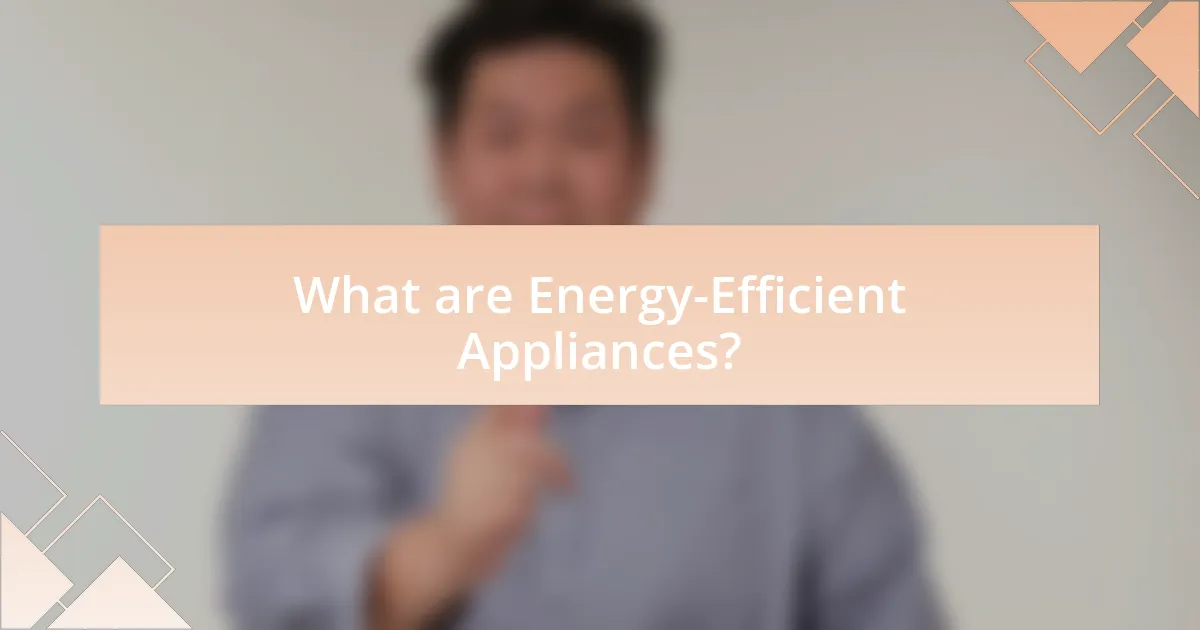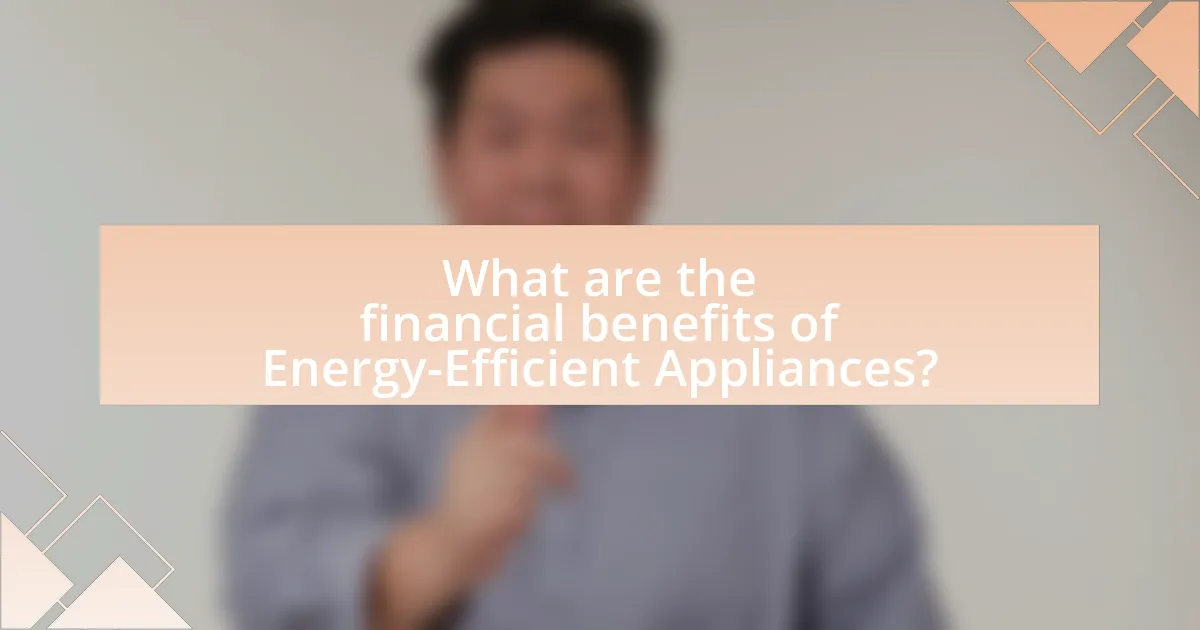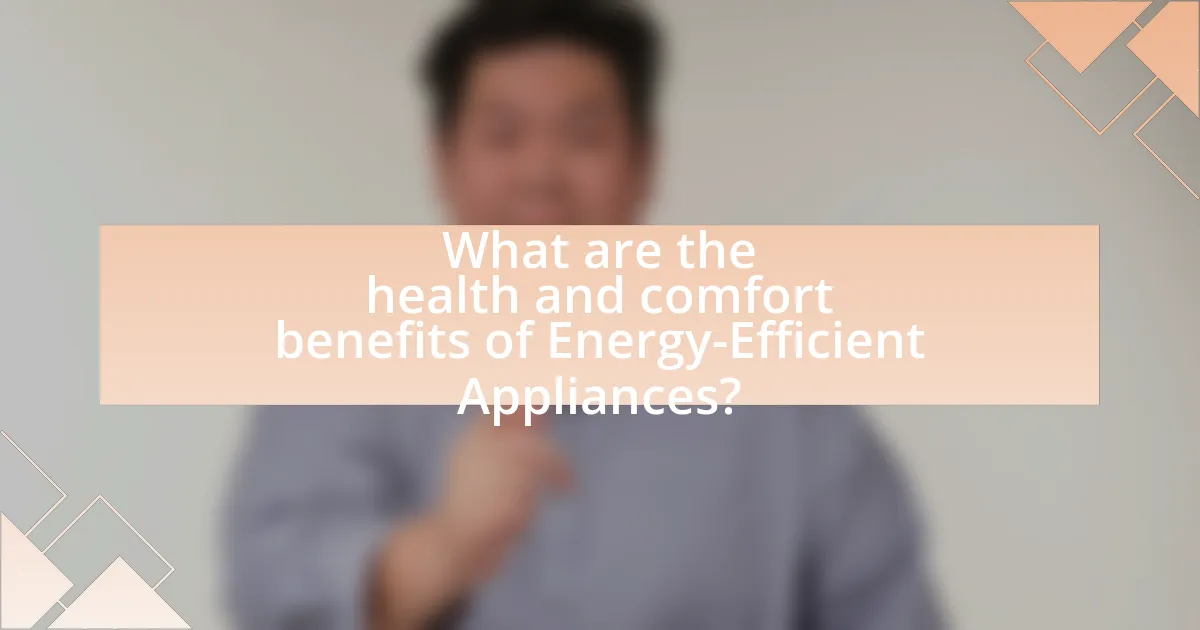Energy-efficient appliances are designed to consume less energy while delivering the same performance as traditional models, leading to significant cost savings and environmental benefits. These appliances utilize advanced technologies such as inverter systems, smart sensors, and improved insulation to optimize energy use, resulting in reduced utility bills and lower greenhouse gas emissions. The article explores the differences between energy-efficient and traditional appliances, the technologies that enhance their efficiency, and the financial and health benefits they provide in residential settings. Additionally, it discusses how to measure energy efficiency, the impact on household energy consumption, and best practices for selecting and maximizing the benefits of energy-efficient appliances.

What are Energy-Efficient Appliances?
Energy-efficient appliances are devices designed to use less energy while performing the same tasks as standard appliances. These appliances often meet specific energy efficiency standards set by organizations such as the U.S. Department of Energy or the Environmental Protection Agency, which can include features like improved insulation, advanced technology, and optimized performance. For example, Energy Star-rated appliances consume significantly less energy than their non-rated counterparts, leading to reduced utility bills and lower greenhouse gas emissions.
How do Energy-Efficient Appliances differ from traditional appliances?
Energy-efficient appliances differ from traditional appliances primarily in their energy consumption and operational efficiency. Energy-efficient appliances are designed to use less electricity or gas while providing the same level of performance, often achieving this through advanced technology and better insulation. For example, the U.S. Department of Energy states that energy-efficient appliances can use 10% to 50% less energy than their traditional counterparts, leading to significant cost savings on utility bills over time. Additionally, these appliances often have features such as smart technology that optimizes energy use based on user habits, further enhancing their efficiency compared to traditional models.
What technologies are used in Energy-Efficient Appliances?
Energy-efficient appliances utilize technologies such as inverter technology, smart sensors, and advanced insulation to reduce energy consumption. Inverter technology allows motors to operate at variable speeds, optimizing energy use based on demand, which is commonly found in air conditioners and refrigerators. Smart sensors adjust appliance operation based on real-time conditions, enhancing efficiency in devices like washing machines and dishwashers. Advanced insulation materials minimize heat loss in refrigerators and ovens, further contributing to energy savings. These technologies collectively lead to significant reductions in energy usage, often resulting in lower utility bills and a smaller carbon footprint for households.
How is energy efficiency measured in appliances?
Energy efficiency in appliances is measured using metrics such as Energy Factor (EF), Annual Energy Consumption (AEC), and Energy Star ratings. Energy Factor quantifies the efficiency of appliances like water heaters, indicating how much hot water is produced per unit of energy consumed. Annual Energy Consumption estimates the total energy usage of an appliance over a year, allowing consumers to compare energy costs. Energy Star ratings, established by the U.S. Environmental Protection Agency, signify that an appliance meets specific energy efficiency criteria, providing a benchmark for consumers to identify energy-saving products. These measurement methods help consumers make informed choices, ultimately leading to reduced energy consumption and lower utility bills.
Why are Energy-Efficient Appliances important for residential settings?
Energy-efficient appliances are important for residential settings because they significantly reduce energy consumption, leading to lower utility bills and a smaller carbon footprint. These appliances use advanced technology to minimize energy waste; for instance, Energy Star-rated products can save households up to 30% on energy costs compared to standard models. Additionally, widespread adoption of energy-efficient appliances contributes to reduced demand on power plants, which can decrease greenhouse gas emissions and promote environmental sustainability.
What impact do they have on household energy consumption?
Energy-efficient appliances significantly reduce household energy consumption. These appliances use advanced technology to minimize energy use while maintaining performance, leading to lower utility bills and reduced environmental impact. For instance, the U.S. Department of Energy states that energy-efficient appliances can save households up to 30% on energy costs compared to standard models. This reduction in energy consumption contributes to decreased greenhouse gas emissions, supporting sustainability efforts.
How do they contribute to environmental sustainability?
Energy-efficient appliances contribute to environmental sustainability by reducing energy consumption and minimizing greenhouse gas emissions. These appliances use advanced technology to operate more efficiently, which leads to lower electricity usage. For instance, the U.S. Department of Energy states that energy-efficient appliances can reduce energy use by 10-50% compared to standard models. This reduction in energy demand decreases the reliance on fossil fuels, thereby lowering carbon emissions and mitigating climate change impacts. Additionally, energy-efficient appliances often have a longer lifespan, which reduces waste and the frequency of replacements, further supporting sustainability efforts.

What are the financial benefits of Energy-Efficient Appliances?
Energy-efficient appliances provide significant financial benefits by reducing energy consumption, which leads to lower utility bills. For instance, the U.S. Department of Energy states that energy-efficient appliances can save households between $100 to $400 annually on energy costs. Additionally, these appliances often qualify for rebates and tax incentives, further decreasing initial purchase costs. Over their lifespan, energy-efficient models can save consumers thousands of dollars compared to standard appliances, as they typically have longer lifespans and require less maintenance.
How do Energy-Efficient Appliances reduce utility bills?
Energy-efficient appliances reduce utility bills by consuming less electricity and water compared to standard models. These appliances are designed with advanced technology that optimizes energy use, leading to lower consumption rates. For instance, Energy Star-rated appliances use about 10-50% less energy than their non-efficient counterparts, which directly translates to reduced monthly utility costs. Additionally, the U.S. Department of Energy reports that households can save an average of $500 annually by replacing old appliances with energy-efficient ones, further validating the financial benefits of these products.
What are the long-term savings associated with these appliances?
Energy-efficient appliances can lead to long-term savings of up to 30% on utility bills compared to standard models. This reduction in energy consumption translates to significant financial savings over the lifespan of the appliances, which typically ranges from 10 to 15 years. For example, the U.S. Department of Energy estimates that households can save an average of $500 annually by using energy-efficient appliances, resulting in total savings of $5,000 to $7,500 over the appliance’s lifetime. Additionally, these appliances often qualify for rebates and tax incentives, further enhancing their cost-effectiveness.
How do rebates and incentives affect the cost of Energy-Efficient Appliances?
Rebates and incentives significantly reduce the upfront cost of energy-efficient appliances, making them more financially accessible for consumers. For instance, federal and state programs often provide cash rebates that can range from $50 to $500, depending on the appliance type and energy savings achieved. According to the U.S. Department of Energy, these financial incentives can lower the initial purchase price, encouraging consumers to choose energy-efficient options over standard models. As a result, the overall cost of ownership decreases, as energy-efficient appliances typically consume less electricity, leading to lower utility bills over time.
What is the return on investment for Energy-Efficient Appliances?
The return on investment (ROI) for energy-efficient appliances typically ranges from 10% to 30% annually. This ROI is derived from the significant energy savings these appliances provide, which can amount to hundreds of dollars per year on utility bills. For instance, the U.S. Department of Energy states that energy-efficient appliances can save homeowners approximately $500 to $1,000 over their lifetime, depending on the appliance type and usage. This financial benefit, combined with potential rebates and incentives from utility companies, reinforces the economic advantages of investing in energy-efficient appliances.
How can homeowners calculate their savings over time?
Homeowners can calculate their savings over time by comparing their energy bills before and after installing energy-efficient appliances. This involves tracking monthly energy usage and costs, then calculating the difference in expenses attributable to the new appliances. For instance, if an energy-efficient refrigerator reduces electricity consumption by 200 kilowatt-hours per month, and the cost per kilowatt-hour is $0.12, the monthly savings would be $24. Over a year, this results in $288 in savings. Additionally, homeowners can use online calculators provided by energy companies to estimate long-term savings based on appliance efficiency ratings and local energy costs.
What factors influence the payback period for these appliances?
The payback period for energy-efficient appliances is influenced by initial cost, energy savings, maintenance costs, and usage patterns. The initial cost refers to the purchase price of the appliance, which can be higher for energy-efficient models compared to standard ones. Energy savings are calculated based on the reduction in utility bills due to lower energy consumption, which can vary significantly depending on the appliance type and local energy rates. Maintenance costs also play a role; energy-efficient appliances may require less frequent repairs or lower operational costs over time. Lastly, usage patterns, such as how often and in what manner the appliance is used, directly affect the overall savings and, consequently, the payback period. For example, a study by the U.S. Department of Energy found that households can save between 10% to 50% on energy bills with energy-efficient appliances, significantly impacting the payback period.

What are the health and comfort benefits of Energy-Efficient Appliances?
Energy-efficient appliances provide significant health and comfort benefits by improving indoor air quality and reducing noise levels. These appliances often utilize advanced technology that minimizes energy consumption, which in turn reduces the emission of pollutants and allergens, leading to a healthier living environment. For instance, Energy Star-rated appliances are designed to operate more efficiently, which can lower humidity levels and prevent mold growth, a common health hazard in homes. Additionally, energy-efficient appliances typically operate more quietly than their less efficient counterparts, contributing to a more peaceful home atmosphere. Studies have shown that reduced noise pollution can enhance overall well-being and comfort, making energy-efficient appliances a valuable investment for residential settings.
How do Energy-Efficient Appliances improve indoor air quality?
Energy-efficient appliances improve indoor air quality by reducing the emission of pollutants and allergens. These appliances often utilize advanced technologies that minimize energy consumption and enhance ventilation, which helps to lower humidity levels and prevent mold growth. For instance, Energy Star-rated appliances are designed to operate more efficiently, leading to less energy waste and lower levels of indoor air contaminants. Studies have shown that homes using energy-efficient appliances report fewer instances of respiratory issues and allergies, as these appliances contribute to a cleaner and healthier indoor environment.
What role do these appliances play in reducing allergens and pollutants?
Energy-efficient appliances play a significant role in reducing allergens and pollutants by utilizing advanced filtration systems and improved energy management. These appliances, such as air purifiers and HVAC systems, often include HEPA filters that capture airborne particles, including dust, pollen, and pet dander, effectively lowering allergen levels in indoor environments. Additionally, energy-efficient designs minimize the release of harmful emissions, contributing to better air quality. For instance, a study published in the Journal of Environmental Health found that homes equipped with energy-efficient HVAC systems showed a 30% reduction in indoor air pollutants compared to traditional systems. This evidence underscores the effectiveness of these appliances in promoting healthier living spaces.
How can they enhance overall home comfort?
Energy-efficient appliances enhance overall home comfort by maintaining consistent indoor temperatures and reducing humidity levels. These appliances, such as energy-efficient HVAC systems and smart thermostats, optimize energy use, leading to improved air quality and a more stable environment. For instance, according to the U.S. Department of Energy, energy-efficient heating and cooling systems can reduce energy consumption by 20-50%, which not only lowers utility bills but also minimizes temperature fluctuations, contributing to a more comfortable living space.
What are the potential drawbacks of Energy-Efficient Appliances?
Energy-efficient appliances can have several potential drawbacks, including higher upfront costs, limited availability, and performance issues. The initial purchase price of energy-efficient models is often significantly greater than that of standard appliances, which can deter consumers despite long-term savings on energy bills. Additionally, some energy-efficient appliances may not be as widely available, leading to fewer choices for consumers. Performance can also be a concern; certain energy-efficient models may not operate as effectively or may have longer cycle times compared to traditional appliances, which can impact user satisfaction.
Are there any initial costs that homeowners should be aware of?
Homeowners should be aware of several initial costs when considering energy-efficient appliances. These costs typically include the purchase price of the appliances, which can be higher than standard models due to advanced technology and energy-saving features. For instance, Energy Star-rated appliances often come with a premium of 10% to 50% over non-rated counterparts. Additionally, homeowners may incur installation costs, which can vary based on the complexity of the installation and local labor rates. Furthermore, there may be costs associated with removing old appliances and potential modifications to existing plumbing or electrical systems to accommodate new units. These initial expenses are important to consider as they can impact the overall budget for upgrading to energy-efficient appliances.
How do maintenance and repair costs compare to traditional appliances?
Maintenance and repair costs for energy-efficient appliances are generally lower compared to traditional appliances. Energy-efficient models often utilize advanced technology that enhances durability and reduces wear and tear, leading to fewer breakdowns. For instance, a study by the American Council for an Energy-Efficient Economy found that energy-efficient appliances can save homeowners up to 30% on maintenance costs over their lifespan. This reduction is attributed to improved components and design that minimize the likelihood of repairs.
What are the best practices for selecting Energy-Efficient Appliances?
The best practices for selecting energy-efficient appliances include looking for the ENERGY STAR label, comparing energy consumption ratings, considering the size and capacity needed, and evaluating the appliance’s features for energy-saving options. The ENERGY STAR label indicates that the appliance meets strict energy efficiency guidelines set by the U.S. Environmental Protection Agency, which can lead to significant energy savings. For example, ENERGY STAR certified appliances use about 10-50% less energy than standard models. Additionally, comparing the energy consumption ratings, often found on the yellow EnergyGuide label, helps consumers understand the long-term operating costs. Choosing the right size and capacity ensures that the appliance operates efficiently without wasting energy. Lastly, evaluating features such as programmable settings or eco-modes can further enhance energy savings.
How can homeowners identify the most efficient models available?
Homeowners can identify the most efficient models available by looking for the ENERGY STAR label, which signifies that the appliance meets strict energy efficiency guidelines set by the U.S. Environmental Protection Agency. Additionally, homeowners should compare the EnergyGuide labels, which provide information on the estimated annual energy consumption and operating costs of appliances. Research indicates that ENERGY STAR certified appliances can save homeowners up to 30% on energy bills compared to non-certified models, making them a reliable choice for efficiency.
What certifications should consumers look for when purchasing these appliances?
Consumers should look for certifications such as ENERGY STAR, which indicates that an appliance meets energy efficiency guidelines set by the U.S. Environmental Protection Agency. ENERGY STAR-certified appliances typically use 10-50% less energy than standard models, contributing to lower utility bills and reduced greenhouse gas emissions. Additionally, consumers may consider the Consortium for Energy Efficiency (CEE) certification, which identifies high-efficiency products that exceed minimum energy performance standards. These certifications provide assurance that the appliances are designed to save energy and reduce environmental impact.
How can homeowners maximize the benefits of Energy-Efficient Appliances?
Homeowners can maximize the benefits of energy-efficient appliances by selecting ENERGY STAR certified products, which are designed to use less energy and water compared to standard models. These appliances can reduce energy bills by 10-50%, depending on the type of appliance and usage patterns. Additionally, homeowners should ensure proper installation and maintenance, as this can further enhance efficiency; for example, regularly cleaning filters in HVAC systems can improve performance. Utilizing appliances during off-peak hours can also lead to cost savings, as energy rates are often lower during these times. By implementing these strategies, homeowners can significantly increase the financial and environmental benefits of their energy-efficient appliances.